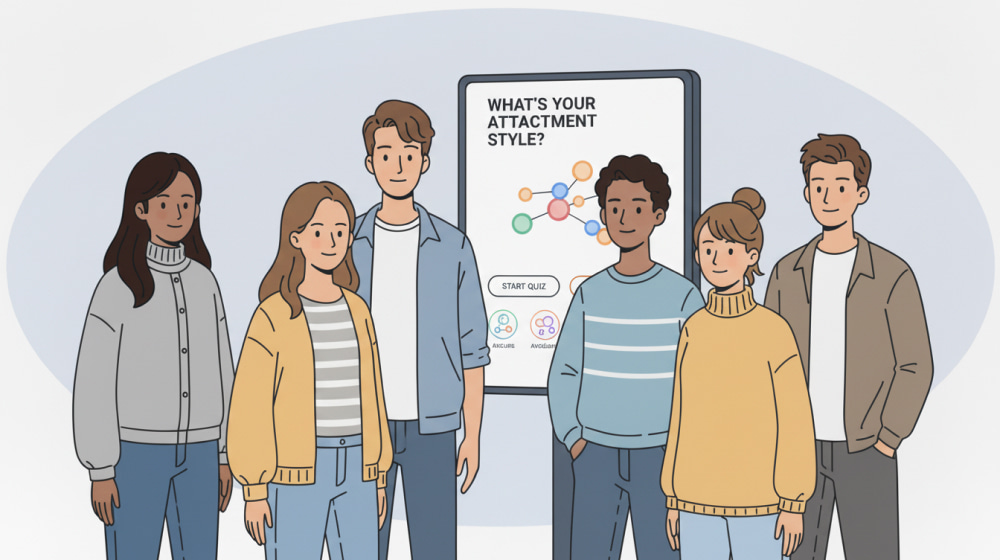
Discover Your Relationship Blueprint
Our lifelong relationship blueprint often forms in early caregiving environments, shaping how we seek closeness, manage distance, and repair conflict. By decoding these patterns, you can gain a language for behavior that once felt confusing, and you can make deliberate choices about how to engage with partners, friends, and colleagues. When curiosity builds, many people explore an attachment styles quiz to translate academic concepts into personally meaningful insights that feel actionable.
How You Connect
For a research-grounded snapshot, some learners try an attachment theory quiz that distills core tendencies and highlights the interplay between comfort with intimacy and confidence in responsiveness. That translation empowers you to spot patterns in communication, boundary setting, and emotional regulation without pathologizing yourself or others. If you prefer a brief overview before diving deeper, a concise attachment type quiz can surface a dominant pattern while pointing to secondary nuances that color your reactions under stress.

How to Take and Interpret Results Without Overthinking
Before answering, remind yourself that a what is your attachment style quiz reflects learned habits that can evolve through insight, practice, and supportive relationships. As you consider options, choose the response that describes what you actually do most of the time, not what you wish you did on your best day. That practical mindset improves the signal in your outcome.

Because wording can subtly sway responses, it helps to pick tools that minimize bias and maximize clarity. To reduce confusion, select a quiz attachment style with transparent scoring, plain-language questions, and detailed explanations of each category. Clear feedback pages and examples of how patterns appear in daily life will make your results easier to apply. If starting feels daunting, it can be helpful to orient yourself with an accessible entry point. Many people begin with a what attachment style am i quiz and then revisit insights after noticing their communication habits over a week or two. That reflective cycle helps you refine understanding, integrate skills, and celebrate small improvements that compound over time.
Learh Benefits
Adults juggling careers and commitments often need pragmatic tools that slot into busy schedules. Because time is limited, an attachment style quiz for adults can focus reflection on themes like trust, autonomy, and repair strategies that apply directly to work and home. The resulting clarity streamlines conversations about needs, expectations, and shared routines, reducing friction and deepening connection.

Improve Relationships With an Attachment Style Quiz
Adolescents experience rapid social development and can benefit from structured language that normalizes their feelings. Educators and caregivers sometimes introduce an attachment style quiz for teens as part of wellness curricula to help students notice patterns around closeness, independence, and conflict. With a supportive context, teens learn that tendencies can shift through practice, which encourages empathy and healthier peer dynamics. Dyads gain a shared map when they explore patterns together in a spirit of curiosity rather than blame. Couples seeking common ground may appreciate a relationship attachment style quiz that offers prompts for dialogue, repair rituals, and co-regulation tips. When both partners understand each other’s signals and soothe effectively, trust grows and intimacy becomes easier to sustain.

Choosing an Online Experience and Comparing Features
Budget can influence your options, yet value doesn’t always correlate with price. Learners who want to minimize costs may try a free attachment style quiz that still offers detailed feedback and actionable suggestions. When anonymity matters, an attachment style online quiz hosted by reputable platforms helps you explore sensitive topics without sacrificing privacy or control. Comparison at a glance helps you select the right fit for your goals and available time. For a quick warm-up before deeper reflection, a concise attachment quiz free option can build momentum without overload, while longer tools can add nuance and context to inform next steps.
| Criterion | What to look for | Why it matters |
|---|---|---|
| Evidence base | References to peer-reviewed research and clear authorship | Increases reliability and reduces misinformation |
| Privacy | Explicit data policy and no unnecessary personal details | Protects sensitive responses and promotes trust |
| Clarity | Plain language, concrete examples, and next-step guidance | Makes results actionable in daily life |
| Length | Estimated completion time and option to pause | Fits your schedule and reduces fatigue |
| Accessibility | Mobile-friendly design and inclusive wording | Ensures a comfortable, equitable user experience |
Track Your Progress
If you want a cost-conscious entry point, learners can begin with an attachment styles quiz free and then layer on deeper reading, podcasts, or coaching to widen perspective. Specific goals like improving conflict repair or communicating needs make it easier to apply guidance and measure progress across different situations.

Compare Your Patterns Across Relationships With a Quiz
Personalization further strengthens your growth curve, especially when you track patterns across settings. Consider keeping notes after completing a my attachment style quiz so you can compare how you show up with family, friends, and colleagues. That observant approach helps you celebrate wins, refine plans, and sustain motivation when challenges arise.
Short on time does not mean short on insight, particularly if you pick frictionless tools that you can complete during a break. Even with a busy day, you can build clarity by trying an attachment style quiz free between meetings and then scheduling a focused review later. Over time, revisit results to see how your efforts shift confidence, closeness, and repair capacity.
Frequently Asked Questions
The Latest News



Please Note
This website (attachment-style-quiz.com) is not an official representative, creator or developer of this application, or product. All the copyrighted materials belong to their respective owners. All the content on this website is used for educational and informative purposes only.
